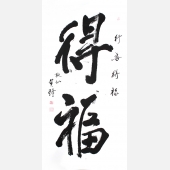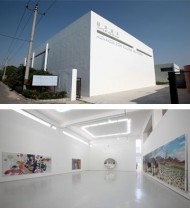- 资质:AGA
- 评分:
1分 2分 3分 4分 5分 6分 7分 8分 9分 10分 3.2分
- 印象:
- 经营时间:21年
- 展厅面积:
- 地 区:北京-朝阳-草场地
何翔宇:椅子上的人 HE XIANGYU: MAN ON THE CHAIRS
2011-06-22 14:37:38
�
展览现场
2011年
北京空白空间
View of “Man on the
Chairs”
2011
《椅子上的人》的表演现场,事先得到提示的几位舞蹈演员奋力地穿行、翻越并徘徊于空间之中,在欣赏动态并揣摩情节之余,观众很快会发现这一表演的重点,即作为“地面”而存在的椅群,它以道具或布景的面貌出现,却实质支配着整个现场。值得思忖的是这些木椅的来源—何翔宇将云南山区废弃的古老原木水渠拆卸并运至北京,再经木匠的反复择选、打磨、上漆后随木料原形悉数加工成不规则状的椅子,全部为榫卯结构,貌拙且重心极稳。每一把木椅的材质都有差别,这是因为水渠在建造时所用木料皆为随机之选;在经年累月的积水冲刷和风化侵蚀后,这些硬木变得老朽而枯槁,再度成型为椅子便有天然的苦涩气息和沧桑感,时间的刻印赋予它们以历史的重量。就是在这些木椅上,舞者排演着看似漫不经心的游戏,游戏规则是不能掉落于椅群—一旦离开“地面”就意味着死亡.
随着情节的推进,一位舞者在疲惫和不稳中行将跌倒,其他舞者则试图奋力抢救,这一切的情绪挣扎铺展在无声的环境中,最终随着舞者的倒下和“死亡”达到压抑和愤怒的顶峰。看起来似乎是一个颇为悲壮的情节设定,但同一场景内神态麻木的清洁工反复擦拭椅子的动作则打破了这种气氛,成为干扰性的存在。这样,在老式灯泡映照出的昏黄光线下,一次社会学层面上的质性研究清晰地展开,何翔宇借此抒发他对于某种当下的社会构成的理解,它既关乎于人生体察,也影射了群体性的政治经验。
不难读出这个展览的关键词,它们是时间、生命、死亡、以及与体制有关的隐喻和衍生概念,这些被无限次讨论的话题在何翔宇的叙述中有节奏地浮现或隐没,一种仪式感抽离于其中,予言语本身以多义性。整个展览可以被看作一个剧场,现场表演仅仅出现在开幕式,其后便是场景和录像资料的展示。这样的切换使得未能亲历表演的观众在步入展厅后有一种寻找某段历史遗迹的穿越感,而这或许是材料本身所带来的意外效果。客观地说,这是一个在逻辑语言和形式转换上都清晰而准确的展览,它似乎预先考虑到每一种可能的语义解读并为之提供线索;在单一主题的框架中,布展方式也恰如其分。观众或许会对这种思路较直接的工作方式稍有疑问,但对艺术家而言这未必不是深化形式练习的稳妥方式。
作为一个快速成长的年轻艺术家,何翔宇在不算长的创作履历中实践着材料和形式语言的丰富性。此次个展可以说是对其代表作《可乐计划》的延续—在《可乐计划》中,何翔宇耗费时间、财力和人工将一百多吨可乐烧干,余存物为一堆黑色残渣—尽管形式上的迥异区分了两件作品的实际面貌,但对于“物”的审视、判断以及转换则使二者在同一理性的结构中趋于一致。此外颇有意味的是,相比于作品内部的问题,《椅子上的人》出现在这一话题集中的时期,似乎更容易引发观众对于其情节和细节的象征性的揣摩,展览借此被解读为艺术家对当下政治和舆论环境做出的反应,这可能在何翔宇的预期之外。
�
For the performance of Man on The Chairs, a group of trained dancers, following instructions and exerting great effort, clambered back and forth across the gallery space. Admiring this scene, and trying to figure out the narrative of the performance, spectators soon realize that its crux lies in an emphasis of the new “surface” created by the chairs, their conventional function as stage props exaggerated to the extent that they dominated the entire space.
Worth considering is the origin of these wooden chairs. He Xiangyu first salvaged wooden logs from an old canal in a mountainous part of
As the narrative unfolded, one of the performers, now weary, and unsteadily traversing the chairs, falls to the ground. The other performers try their best to save him. This whole struggle is enacted in complete silence; meanwhile, the otherwise solemn tone of the performance was punctuated by the regular appearance of an expressionless gallery cleaner, who meticulously scrubs the chairs. And so, under the dim glow of old-fashioned light bulbs, a distinctly sociological aspect of this exhibition emerged, clearly betraying He Xiangyu’s understanding of contemporary social structures, hinting at basic human experience, and reflecting a distinctly politicized experience of communality.
Time, life, death, systems, organizations: it isn’t difficult to suss the essential keywords of this exhibition. These themes, new to no one, float in and out of He He Xiangyu’s narrative. Producing an almost ceremonial atmosphere and lending its language a certain equivocality, ambiguity. The exhibition could be regarded as a piece of theatre, the performance of which took place only on the opening night. Thereafter only the stage set, as well as video documentation of the performance, remained. Subsequent visitors saw only an accidental, residual, historical document. Objectively speaking, and on a level of logical articulation and formal transferral, this is a clear and concise exhibition, thoroughly considered prior to its realization and consciously peppered with clues to aid possible attempts at its decoding. Though if viewed within a single thematic framework, its formal arrangement remains coherent. Visitors to this exhibition might have some queries regarding the artist’s direct modus operandi; such a rigorous formal exercise is indispensible to the artist’s creative practice.
He Xiangyu is a young artist, but quickly developing a richness material and formal language. This solo exhibition could be viewed as a continuation of his Coca-Cola Project, for which he squandered time, money and human resources boiling over 100 tons of Coca-Cola until it turned into a heap of black crystalline matter. Although on a formal level the two works appear totally different, in their close observation of “matter,” in their planning and transformative process, they are in fact brought under a single compositional rationale. Thus, despite the themes which define Man on the Chairs, this piece could be considered representative of a period of distinct conceptual and thematic focus, and this may make it easier for the observer to unravel its symbolic riddles. However, this exhibition can also be read as the artist’s response to the contemporary political and social atmosphere, even if these particular reverberations were quite possibly not part of his original intentions. Zhang Xiyuan (Translated by Dominik Salter Dvorak)
�

 黄琦
黄琦 测试用艺术
测试用艺术




